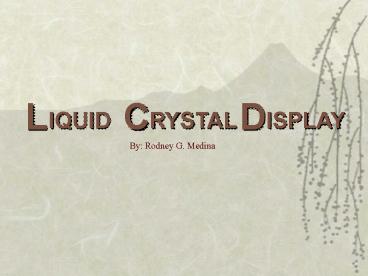LIQUID CRYSTAL DISPLAY LCDs - PowerPoint PPT Presentation
1 / 15
Title:
LIQUID CRYSTAL DISPLAY LCDs
Description:
Only when a British scientist discovered 'Biphenyl', a stable liquid ... Do not flicker like CRTs. Are light and slim in size. Full viewable size. Uses of LCD: ... – PowerPoint PPT presentation
Number of Views:1281
Avg rating:3.0/5.0
Title: LIQUID CRYSTAL DISPLAY LCDs
1
L
C
D
IQUID
RYSTAL
ISPLAY
By Rodney G. Medina
2
- History of LCD
- In 1970, Fergason made the first operating LCD.
- In 1971, the first LCD were demonstrated publicly
and enthusiastically accepted. - Early version of LCD were unstable and unsuitable
for mass production. Only when a British
scientist discovered "Biphenyl", a stable liquid
crystal material, that made it possible for LCD
technology to take off. The first generation LCD
appeared on calculators, then game sets and
watches.
Rodney G. Medina
3
- What are Liquid Crystals
- LCD stands for Liquid Crystal Display are organic
substances that reflect light when voltage is
applied. The liquid crystal display consists of a
liquid suspension between two glass or plastic
panels. Crystals in this suspension are naturally
aligned parallel with one another, allowing light
to pass through the panel. When electric current
is applied, the crystals change orientation and
block light instead of allowing it pass through,
turning the crystal region dark
Rodney G. Medina
4
- Kinds of Liquid Crystal
- Nematic Liquid Crystal types have the rod-like
molecules oriented parallel to one another but
have no layer structure. - Twisted Nematic has a segment appearance and thin
layer of encapsulated liquid crystal.
Rodney G. Medina
5
Conductive Clear Coating
Incident Light
Clear Region
V
Frosted Region
Nemantic Liquid Crystal
Rodney G. Medina
6
- Kinds of LCD
- Transmissive Field Effect LCD
- Internal light source is on the right and the
viewer is on the left. Only the vertical
component of the entering light on the right can
pass through the vertical light polarizer on the
right. If there is no applied voltage to the
conducting surfaces, the vertically polarized
light enters the liquid crystal region and
follows the 90 bending of the molecular
structure. Its horizontal polarization to the
left hand vertical light polarizer does not allow
it to pass through, and the viewer sees a
uniformly dark pattern across the entire display.
Rodney G. Medina
7
Tranmissive Field-Effect LCD
Vertical light Polarizer
x
Eye
Incident light
Clear conducting surfaces to which applied bias
is connected
Vertical rod
Horizontal rod
Rodney G. Medina
8
- Reflective Field Effect LCD
- The horizontally polarized Light at the far left
encounters a horizontally polarized filter and
passes trough to the reflector, where it is
reflected back into the liquid crystal, bent back
into the other vertical polarization, and return
to the observer. If there is no applied voltage,
there is a uniformly lit display. The application
of the voltage results in a vertically incedent
light encountering a horizontally polarzed filter
at the left which it will not be able to pass
through and be reflected.
Rodney G. Medina
9
Reflective Field-Effect LCD
Glass
Reflector
x
Incident light
Eye
Clear conducting surfaces to which applied bias
is connected
Vertical Light Polarizer
Rodney G. Medina
10
- How an LCD work
- LCDs work using these 4 concepts
- Light can be polarized.
- Liquid crystals can transmit and change polarized
light. - The structure of liquid crystals can be changed
by electric current. - There are transparent substances that can conduct
electricity.
Rodney G. Medina
11
How an LCD works? The cross-section of the TFT
LCD panel looks like a multi-layer sandwich. At
the outermost layer on either side are clear
glass substrates. Between the substrates are the
thin film transistor, colour filter panel that
provides you the necessary red, blue and green
primary colours, and the liquid crystal layer.
Completing the LCD is a fluorescent backlight
that illuminates the screen from beneath. Under
normal conditions when there is no electrical
charge, the liquid crystals are in an amorphous
state. In this state, the liquid crystal pass
through. By subjecting the liquid crystal layer
to varying amount of electrical charges, the
liquid crystal layer will allow different amount
of light to pass through, as they orientate
themselves according to the control center for
the liquid crystals.
Rodney G. Medina
12
Just like in an ordinary CRT, the red, green and
blue liquid crystal "chambers" make up one pixel
(picture element). By subjecting the red, green,
blue chambers to varying degrees of electrical
charges, different colours can be achieved. An
entire TFT screen is made up of a grid of pixel,
with each pixel having a transistor turning it on
or off. This is where you get your resolution.
Thus, for an LCD to provide a screen resolution
1024 x 768 pixel (SVGA), it must have that number
of pixels.
Rodney G. Medina
13
- The advantages of LCD monitors
- LCD monitors consume less power
- Do not produce electromagnetic radiation as CRTs
do - Do not flicker like CRTs
- Are light and slim in size
- Full viewable size
- Uses of LCD
- Computers 4. Laptops
- Thermometers 5. Cellphones
- Mood Rings
Rodney G. Medina
14
A simple LCD display from a calculator
Rodney G. Medina
15
Rodney G. Medina































